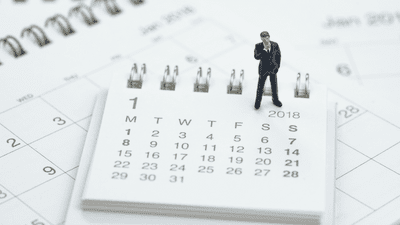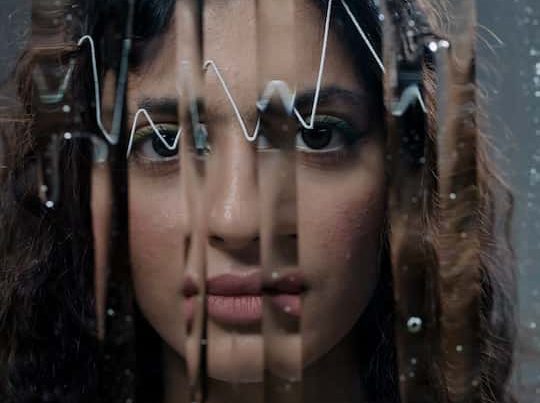Here’s the weirdest part: you might even have a little bit of it yourself.
How far away is 2050? No, this isn’t a math test – we mean it literally. Could you reach out and touch 2050, or would you have to walk there? Is it in front of you, or around a few corners? Or is this all just gibberish?
For maybe one person in 50, though, it makes perfect sense. That’s because they have a secret, albeit very limited, superpower: they can see time. Really.
What is “calendar synesthesia”?
Imagine if your calendar wasn’t an app on your phone or a still-shrinkwrapped decorative holiday gift from your grandma, but just kind of… all around you. That’s what happens for people with calendar synesthesia, also known as time-space synesthesia: for them, time isn’t just a philosophical headache – it’s a collection of points in space; interlocking regions around the body; an enormous hula hoop; or any number of other strange and unique visual manifestations.
“The past is to my right but it curves around so that between 1996 and 2000, it completes a U-turn and runs back to the left,” explained writer and time-space synesthete Emma Yeomans in a Buzzfeed article from a couple of inches behind your right elbow – sorry, we mean 2016.
“[It] does mean that calendars feel faintly odd, as they read left to right,” she admitted. “While this bothered me a little as a child, I don’t much notice the discrepancy anymore.”
Not everybody who has the condition experiences time like this – akin, in Yeomans’s words, to the Rainbow Road track in Mario Kart. For one synesthete, the year may stretch out in a large horseshoe shape; for others, the months could progress clockwise along a hoop, or a V-shape, with their bodies acting as anchors.
We’re not being metaphorical here. “We found that (1) [study participant] ML could ‘read off’ months of her calendar – or alternate months – backward, unlike controls; (2) her eyes and index finger unconsciously ‘tracked’ her reading; (3) her calendar moved with her gaze and tilted with her head; (4) after looking at a contracting spiral, her calendar expanded,” explained a 2016 paper on the phenomenon. Meanwhile another participant – one whose calendar was rooted on her body rather than her head – reported that memories could be partially “blocked” if she turned her gaze away from when they happened.
“December [was] on her right [and] July was 3 feet [0.9 meters] in front of her,” the researchers wrote in a second paper. Intriguingly, when “she rotated her head rightward, the left portion of her calendar became ‘fuzzy’, and memories of February and March became less accessible.”
How common is calendar synesthesia?
One or 2 percent of the population may not sound like a lot, but it adds up to more than 3 million time-space synesthetes in the USA alone. And while it’s not as well-known as other forms of the sense-switching condition, like the ability to “see music” or “taste words”, some reports suggest it may be more common than we think. It could even be one of the most common types of synesthesia out there.
But why would this particular mix-up be so prominent? If you’ve been reading till now and wondering whether you’ve been a little bit of a calendar synesthete all along, you might have hit upon the reason why already.
“If I put a number on a computer screen and ask you to tap a key with your left hand if it’s less than five, or with your right hand if it’s greater than five, you will be faster to respond than if it’s the opposite orientation,” Professor Anina Rich, who leads the Synaesthesia Research Group at Macquarie University in Australia, told ABC News in 2021.
That’s true whether or not you have synesthesia – it’s just a product of our environment. That numbers run from left to right is an idea taught and reinforced to us just about every day of our lives, so it’s not surprising that we would have this association established in our brains – a sort of super-mild version of calendar synesthesia, if you like.
“And then as you’re going along, there might be people who kind of get a sense of where the week is around them,” Rich said. “And then you get someone who says, ‘Oh yeah, I do that for weeks, but I also do it for years and decades.’”
But does that really count? And if not, when does “proper” time-space synesthesia start?
What causes calendar synesthesia?
Perhaps knowing what’s behind the phenomenon might provide some clues – though it’s a pretty big question in its own right.
“Most theories of synesthesia talk about re-wiring or extra-connections in the brain,” wrote Professors Julia Simner and Jamie Ward from the Synesthesia research group at the University of Sussex.
“White matter, which connects different regions together, in the brains of people with synesthesia is organized differently,” they explained, “and there is more grey matter in some regions of the brain relating to perception and attention.”
Meanwhile, there’s longstanding evidence that for people with chromesthesia, or sound-to-color synesthesia, the brain will fire up areas typically used for processing color rather than sound when they hear spoken words. Evidently, there are specific physical differences at the neurological level separating synesthetes from non-synesthetes.
But precisely how big those differences are is still up for debate. On the one hand, Rich explained to ABC News, there’s the school of thought that synesthesia is the result of neural connections most of us simply don’t have.
“That’s categorical,” she said. “That’s saying synesthetes are physically different from non-synesthetes.”
But other experts take “[a] more dimensional approach,” placing synesthetes at one end of a continuum we all sit somewhere along. Under this model, Rich said, “we’ve all got connections between the senses… but it might be that synesthetes have more co-activation [of those regions]” than the rest of us.
In other words, this idea says, we may all be technically capable of seeing next Wednesday in the corner lamp – but, much like just about anything outside our immediate eyeline or the past in general, our brain is constantly overwriting and ignoring it in favor of an easy life.
Are there any benefits to having calendar synesthesia?
So, here’s the million-dollar question: if you’re just now realizing you have this condition – what should you do about it?
Well, the answer may be in the fact that – to put it bluntly – you only just found out you were different. “Often we talk about [synesthesia] as having an unusual gift,” Rich told ABC News. “But for most people, it’s just their way of perceiving the world.”
It’s very rare for calendar synesthesia to cause problems in the daily life of those who experience it, Rich explained – and in fact, it may well bring advantages the rest of us have to train for years to enjoy. Think about Sherlock Holmes’s “mind palace” memory technique and it starts to become clear why: studies have shown that time-space synesthetes are extraordinarily good at visual recall of times and dates, and on a more mundane level, way less likely than you or I to accidentally double-book themselves for an appointment.
“All these advantages make sense,” Simner told Buzzfeed. “If you take two people, one carrying around a diary and one not, the same advantages of carrying around a diary were carried by people who have time-space synesthesia.”
At the end of the day, time-space synesthesia is a fun quirk of perception – and one that may give you an edge in the admin game – but not something you need to worry about. Chances are, if you’re one of the millions of people who experience the phenomenon, you’ve never known you were anything other than normal.
“The vast majority of people with synesthesia never realize that others don’t experience the world in that way,” confirmed Simner. “It’s a challenge to reality – you have your reality, I have mine, and who would have thought that they’d be different?”
Source: People With Calendar Synesthesia Can Literally See Time | IFLScience













